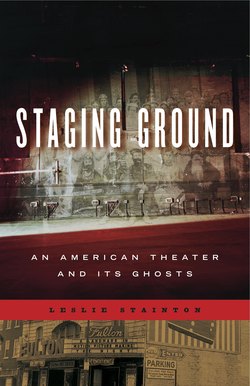Читать книгу Staging Ground - Leslie Stainton - Страница 10
На сайте Литреса книга снята с продажи.
ОглавлениеACKNOWLEDGMENTS
Were it not for the men and women who fought to preserve the Fulton Theatre from demolition in the 1960s—among them my dear friends the late Helen and Nat Hager—this storied site might well be a parking garage today. The late Joe Kingston deserves credit for the series of articles he wrote in the Intelligencer Journal in the mid-1950s, which did much to persuade Lancastrians of the treasure in their midst. Despite his tendency to embellish the facts, Kingston was the first to attempt a comprehensive history of the Fulton Theatre. Ty Greiner followed in 1977 with a two-volume master’s thesis listing every touring show to play the Fulton from 1852 to 1930. His monumental labor has made this book possible in countless ways, and I am deeply grateful.
My friend Barry Kornhauser, former Fulton playwright-in-residence, and his wife, Carol, have been unstintingly generous to me and my family for decades. May this account of a building we all revere serve as partial repayment of the debt I owe them. My thanks to Deidre Simmons, Aaron Young, and the late Michael Mitchell for allowing me to explore the Fulton’s multiple nooks and crannies and to sit in on rehearsals, and to Fulton archivist Mary Underhill for her many efforts on my behalf. Paul E. Yecker Sr. has been a godsend throughout this project, and I am grateful to him and his family for their many kindnesses.
On numerous occasions, director Tom Ryan and the excellent staff of the Lancaster County Historical Society (now LancasterHistory.org)—in particular Kevin Shue, Marianne Heckles, and the late John Loose—opened my eyes to the nuances of Lancaster’s past, as did archivist Joan Kahler of Trinity Lutheran Church; historian Leroy Hopkins; Christopher Raab of Franklin and Marshall College Library; and Peter Siebert, former director of the Heritage Center of Lancaster County. For their knowledge, suggestions, and indispensable reading lists I am indebted to Lynn Brooks, Christopher Densmore, Gregory Dowd, Raymond Grew, Randy Harris, Alison Kibler, Hank Meijer, Martin Walsh, Gwen Waltz, and the late Gerry Lestz. My thanks to Kate Dernacoeur and Ron Grant for their thoughtful comments on the book. Paul Nevin was good enough to take me (and my inveterately curious mother) out to the Susquehanna petroglyphs one gusty October evening, a trip that continues to inspire my dream life. My friend Chris Hager and my brother, Bill Stainton, offered welcome assistance at critical junctures. I am grateful for the help and encouragement of theater design specialists Ann Sachs and Roger Morgan and theater architect Ed Francis, who collectively oversaw the 1995 renovation to the Fulton. Lee Bollinger, Mark Lamos, and Don Wilmeth all lent their support to this project, and I thank them. Lorraine Boncella-Wiley, Don Hammond, and Genny Gumbrecht have provided indispensable technical assistance. Thanks also to my agent, Carol Mann, and her assistant Eliza Dreier for their vision and perseverance.
Jack Brubaker, Gordon Wickstrom, and Julia Kasdorf shared their expertise and read early drafts of the manuscript, and my gratitude to them is boundless. I am indebted to Kathryn Yahner and the fine staff at Penn State Press for their faith in books in general and this one in particular. Helen Sheehy believed in Staging Ground from the start and buoyed my spirits throughout the research and writing process. To my parents, Scarlett and Bill Stainton, who made this book possible in so many ways, my endless gratitude. To Jeremy and Julia Whiting, loyal companions throughout this journey, my thanks and love. And to their father, who keeps me going in all ways and to whom this book is dedicated—everything.
